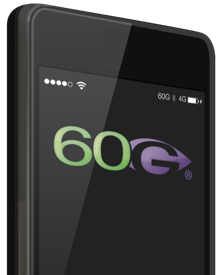866 Mbps Achieved in Unlicensed 60 GHz Band
.Samsung Electronics announced the development of its 60GHz Wi-Fi technology that enables data transmission speeds of up to 4.6Gbps, or 575MB per second, a five-fold increase from 866Mbps, or 108MB per second, the maximum speed possible with existing consumer electronics devices. As a result, a 1GB movie will take less than three seconds to transfer between devices, while uncompressed high-definition videos can easily be streamed from mobile devices to TVs in real-time without any delay.
“Samsung has successfully overcome the barriers to the commercialization of 60GHz millimeter-wave band Wi-Fi technology, and looks forward to commercializing this breakthrough technology,” said Kim Chang Yong, Head of DMC R&D Center of Samsung Electronics. “New and innovative changes await Samsung’s next-generation devices, while new possibilities have been opened up for the future development of Wi-Fi technology.”
Unlike the existing 2.4GHz and 5GHz Wi-Fi technologies, Samsung’s 802.11ad standard 60GHz Wi-Fi technology maintains maximum speed by eliminating co-channel interference, regardless of the number of devices using the same network. By doing so, Samsung’s new technology removes the gap between theoretical and actual speeds, and exhibits actual speed that is more than 10 times faster than that of 2.4GHz and 5GHz Wi-Fi technologies.
Until now, there have been significant challenges in commercially adopting 60GHz Wi-Fi technology , as millimeter waves that travel by line-of-sight has weak penetration properties and is susceptible to path loss, resulting in poor signal and data performance. By leveraging millimeter-wave circuit design and high performance modem technologies and by developing wide-coverage beam-forming antenna, Samsung was able to successfully achieve the highest quality, commercially viable 60GHz Wi-Fi technology.
In addition, Samsung also enhanced the overall signal quality by developing the world’s first micro beam-forming control technology that optimizes the communications module in less than 1/3,000 seconds, in case of any changes in the communications environment. The company also developed the world’s first method that allows multiple devices to connect simultaneously to a network.
As is the case with the 2.4GHz and 5GHz spectrum, the 60GHz is an unlicensed band spectrum across the world, and commercialization is expected as early as next year. Samsung plans to apply this new technology to a wide range of products, including audio visual and medical devices, as well as telecommunications equipment. The technology will also be integral to developments relevant to the Samsung Smart Home and other initiatives related to the Internet of Things
Note the first sentence of the last paragraph: “As is the case with the 2.4GHz and 5GHz spectrum, the 60GHz is an unlicensed band spectrum across the world”. This did not happen by accident. It happened because of FCC initiatives in the 1980s and 90s that recognized technological advances had made new technology possible that was prohibited by anachronistic FCC rules at those times. The initiatives removed those prohibitions but did not require incumbent users to change their operations on bit nor did it increase their interference risk. As a result we have had technical innovation and economic economic growth.

While other WiGig companies like Intel, Wilocity (now owned by Qualcomm) and Nitero have been developing super-fast radios that work 60GHz channel, Samsung claims they’ve actually produced these enhanced speeds by fixing interference issues caused by other devices on the channel.
Now the problem is that the new NOI is rumored to contain a discussion about possible partial or total repurposing of the 60 GHz band for cellular communications, presumably on a licensed basis. The question to be considered on the 8th Floor is how will the fording of the 60 GHz discussion impact capital formation for innovative unlicensed 60 GHz technologies. We are sure the 60 GHz companies have less visibility on the 8th Floor than the major CTIA members and their insatiable demand for spectrum.
We hope the 8th Floor considers carefully the wording of such discussion and its impact on capital formation for ongoing unlicensed 60 GHz systems.



![Validate my RSS feed [Valid RSS]](valid-rss-rogers.png)

